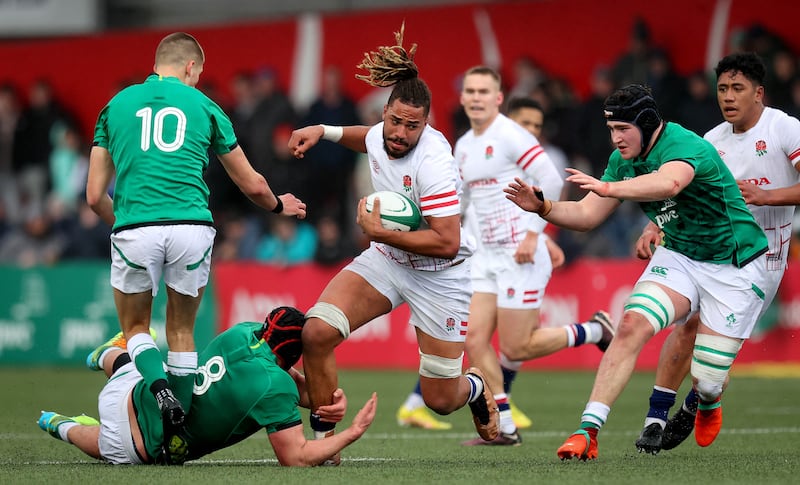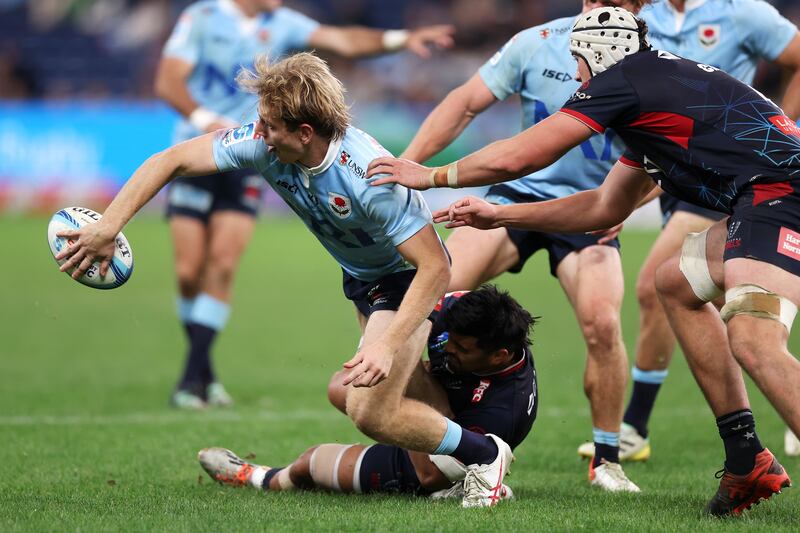There is a familiar white and gold hue to the backdrop. Four years ago, Noel McNamara’s Ireland travelled to Argentina as Six Nations Grand Slam champions for the Under-20 World Championship, where Australia and England awaited in the pool stage.
On Saturday, Richie Murphy’s Ireland, back-to-back Six Nations and Grand Slam winners, will begin their Under-20 World Championship campaign at Paarl Gimnasium, a high school about 60 kilometres from their Cape Town base. England and Australia are once again pool buddies, the only difference is that Fiji rather than Italy will provide the opposition in the third match.
Pulling the strands of coincidence tighter is the fact that there has been no global tournament since 2019 because of the Covid-19 pandemic, so in some respects Ireland’s pre-tournament status hasn’t changed in the interim, albeit that expectation is shouldered by a different coterie.
To synopsise the events of four years ago, Ireland beat England in the pool match, lost to Australia in a game distorted by Ryan Baird’s red card (he had been outstanding in the tournament), hammered Italy to finish second in the pool, and then narrowly lost to England in the first playoff game and to New Zealand in the second, to end up in eighth place.
READ MORE
There is no correlation in players, coaching or style terms between then and now for Ireland, so they might subscribe to Henry Ford’s assertion that history is “more or less bunk”.
Murphy’s 30-man squad contains 26 players who contributed to the Six Nations success along with four uncapped players, Garryowen hooker Max Clein, Old Belvedere tight head prop Ronan Foxe, Dublin University’s Dan Barron, who can play anywhere from secondrow to openside flanker, and Garryowen scrumhalf Jack Oliver. Liam Molony unfortunately misses out through injury.
Ireland open in Paarl against England, a team that they beat 36-24 to claim the Grand Slam at Musgrave Park last March. The final moments of that game brought together England captain Lewis Chessum and Ireland outhalf Sam Prendergast in a fiery exchange that won’t have been forgotten or forgiven, one suspects.
England’s new head coach, Mark Mapletoft, is in his second stint in the job, having previously been in charge in 2009 and 2010. The former London Irish outhalf moved up from the Under-18s to succeed Alan Dickens after the Six Nations.
They travelled to Georgia to prepare for the tournament and after eking out a narrow 41-36 win in the first match, they were beaten 40-38 by their hosts in the second game. England didn’t award caps for either game so there are nine uncapped players in the squad they have taken to the World Cup.
Mapletoft sounded something of a clarion call ahead of the tournament when he said: “The World Rugby Under-20 Championship is the peak of the age-grade calendar and for many this will be the highlight of their rugby journeys so far.
“The players have learned a lot as a team and about themselves this year, including during our Six Nations campaign and on our recent tour of Georgia, and we’ll be better as a group for it. Our squad reflects the diversity and strength of English rugby, with every Premiership club represented, and we trust each player to play with pride every time they pull on an England shirt.”

The English squad contains 17 of the match day 23 from Cork, including several marquee names, such as the big ball-carrying London Irish number eight Chandler Cunningham-South, Charlie Bracken, a son of the Skerries-born former England scrumhalf Kyran, and the joint-leading try scorer in the Six Nations, Toby Elliott, who can play right across the three-quarter line and scored a brace in the defeat to Ireland.
Joe Woodward, a son of former England Lions coach Clive, is a talented centre. Only outhalf Monty Bradbury and secondrow Danny Eite from the English team that started in Cork are missing from the squad that travelled to South Africa.
Australia, under the coaching baton of former 1999 World Cup-winning Wallaby centre Nathan Grey, will have taken huge confidence from a 34-26 victory over New Zealand in Wellington in the first of two test matches as part of their pre-tournament prep.
They gave the Baby Blacks a shellacking in the set-piece, including earning a penalty try following a series of dominant scrums, while winger Ronan Leahy scored a hat-trick of tries. They were pipped 19-18 in the second match following a brace of tries from New Zealand Sevens star, Caleb Tangitau.
Scrumhalf Teddy Wilson, a son of former flanker David, is a pivotal player but the Junior Wallabies were unlucky to lose outhalf Tom Lynagh, Michael’s son, to injury in the build-up to the tournament.
There is plenty of Super Rugby experience throughout the squad with a combined total of 52 matches and 19 starts in the group this season but one notable absentee is 18-year-old Waratahs sensation Max Jorgensen, who has already caught the attention of Wallaby coach Eddie Jones. Force prop Marley Pearce and the 1.9m (6ft 3in) Reds’ centre Taj Annan come with big reputations.

The fourth constituent in Ireland’s pool is Fiji and head coach Ifereimi Rawaqa, a former Sevens and XVs international, said of their chances: “The team has prepared really well. We have had players who were part of the Fijian Warriors [squad] and their experience has really boosted the side.”
Captained by Motikiai Murray, the Fijians have a sprinkling of players from Super Rugby franchises, one of whom, outhalf Isaiah Ravula, has already caught the eye. A product of St Andrew’s College, Christchurch, his quick feet and all-round skills are reminiscent of his uncle, All Black and Crusaders pivot Richie Mo’unga.
France are the defending champions from the last staging in 2019 and probably the tournament favourites, with many of their players having enjoyed considerable game time in the French Top 14 this season. That applies to players such as Clermont Auvergne’s lavishly gifted scrumhalf Baptiste Jauneau and the gargantuan 149kg Perpignan teenager Posolo Tuilagi, son of Samoa’s Henry.Lenny Nouchi (Montpellier) and Nicholas Depoortère (Bordeaux) have also shown impressive potential.
Two of the players from this age-grade with the most match minutes in the Top 14, Bordeaux-Bégles’ Louis Bielle-Biarrey and Pau’s Émilien Gailleton, didn’t travel to South Africa as they were named in Fabien Galthié’s 42-man senior French squad this week.
France lost 33-31 to Ireland in Cork but thereafter handed out some meaty beatings in the Six Nations, including a 42-7 win away to England. They are in a pool with New Zealand, Wales and Japan, whom they face in the first match.
The third and final pool contains South Africa, Argentina, Italy and Georgia, who in victory over England proved that it is not just their senior team that continues to make progress in international rugby.
The three pool winners and the best runner-up qualify for the cup semi-finals, with the same format applying as, depending on results, teams fall into the fifth to eighth and ninth to 12th brackets.
With five games in 25 days for a 30-man squad it is clear that good fortune with injuries will play an integral part in any success, especially when it comes to key players.
Former Connacht secondrow Andrew Browne replaced Willie Faloon (unavailable) in the coaching team from the Six Nations and has brought a few new ideas and dynamism.
Ireland didn’t romp through the Six Nations, instead they showed character aplenty to come back against Wales, squeeze past France and outlast England.
They are an excellent team bolstered by some outstanding individual players but if they wish to surpass the squads of 2004 (Under-21s) and 2016, both of whom were beaten in a World Cup final, they will need to have kicked on again since that Grand Slam success in March.
Rules Trials Panel
As is their wont, World Rugby will use the tournament as a dry-run vehicle for a couple of tweaks. Firstly,a TMO bunker will be used, whereby a player can receive a yellow card and the game will continue while the incident is examined during the 10-minute sinbin period to establish whether it warrants being upgraded to red. Also, ‘smart ball’ technology will again be employed.
The ball technology was first used in last year’s November tests when the data fed back included speed and distance of passes, kick distance and hang time. Beacons around the pitch record the exact position of the ball up to 20 times per second, enabling real-time tracking.
The hope is that it will assist match officials across the metrics of forward passes, where the ball went into touch, whether it was touched in flight, whether it crossed the plane of the try-line (it cannot adjudicate whether a ball was grounded) and crooked throws.
The feedback for the match referee will be instantaneous, with the television match official (TMO) being informed by the operator from Sportable – the company that will run the system – and the TMO will then relay the information to the referee. The latter remains the ultimate arbiter of fact on a pitch irrespective of what’s conveyed from the stands.




















